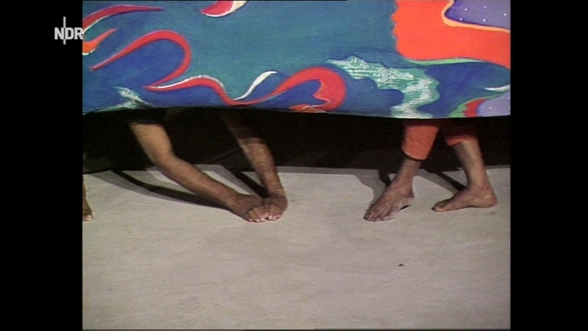Workspace - Unterrichtsmaterialien
Thematic Archive Walk
Gender
Pfade und Programme
The Fifth Wall - Thematic walk through the archive on:
GENDER
Developed by Dr. Rubaica Jaliwala
The digital archive, The Fifth Wall, is a treasure trove of material comprising films, reportages, texts, letters, photos, which is a tremendous resource to discuss themes of interculturality and diversity, gender, racism and migration and to explore strategies to transform hierarchies.
This thematic walk on GENDER is just one example of how the archive can be used for educational purposes. Accordingly, the sessions, process and flow of the thematic walk can be adapted to different settings, contexts and target groups. The programme below can be made interdisciplinary by presenting the archival material within a theoretical framework and using an interactive training methodology.
I. Introduction
1. Trainer introduction
2. Explain the flow and process of the session
3. Brief introduction to the theme
II. Gender identity
1. Film: BUNDESTAG DEBATE ARTICLE 218, 1991 (2:09 mins)
Navina Sundaram’s first and only commentary for the Tagesschau addresses the recurring debate in German Parliament about Article 218 of the Criminal Code that criminalises abortion.
Discussion questions:
- How are women regarded if they are not given the right to decide about their own body?
- What does such a law do to women and men? Who benefits, who loses?
- What is gender?
Bring out how gender identity is ascribed to the bodies of women, how they are regarded in society, what such a law does to women and men.
2. Commentary: NO EDITOR-IN-CHIEF WANTED TO TAKE UP THE TOPIC, 2018 (0:48 mins)
Discussion questions:
- Do women still predominantly address and cover women’s issues?
- Is the reportage ‘Women’s shelters’ relevant today? In what way?
III. Gender norms
1. Film: WOMEN’S SHELTERS, 1983 (1:42 mins)
In this “Tagesschau” reportage, shot in 1983, on Women’s shelters in Germany, Sundaram gives the victims a voice, revealing the power relations between men and women.
Discussion questions:
- Who prescribes gender roles?
- Why is the state primarily interested in restoring classical family relationships?
- What other aspects of social life would be disrupted if there were more independent thinking women who wish to have a say and shape their own lives?
- Are there spaces for gender beyond heteronormativity?
3. Commentary: PRICKLING WITH ANNOYANCE, 2018 (1:00 mins)
Discussion questions:
- What is the problem with “the family being the stronghold of our society”?
Sum up by highlighting power relations between men and women and emphasize that through constant repetition of gender roles and behaviour in society, we make gender norms ‘normal’ and idealise them. In reproducing norms, we give them power.
IV. Gender Discrimination - intersectionality
1. Film excerpts: WOMEN IN POWER, EASY COME, EASY GO, 1977
A talk show with an impression line-up of guests discusses the rise and fall of women in political power in the Global South.
Excerpt 1: 00:00 - 00:22 (22 seconds)
Discussion questions:
- This is a start of a talk show. The very first statement by the moderator. What just happened? Did his opening statement reveal the equality he claimed to have on the panel?
Excerpt 2: 27:31 - 35:05 (7:74 mins)
Discussion questions:
- Can you give me keywords of all the different points you picked up from this discussion? (e.g. role of women in politics in developing countries vs. England, “maternalistic nepotism”, “womanist politics”, feminine qualities important for politics, stereotypes about women, north-south conflict, intersectionality (class, gender, nationality), preserving nuclear families/mother figure/family values/norms as prescribed by the church, racism and gender discrimination)
- Does this scenario seem familiar to you? Is it relevant in the present day?
- Can you tell us about own such experiences?
2. Text: LETTER TO 1ST GERMAN TELEVISION DATED 21.04.1986 (click “open slide show”; letter in German Language only)
Discussion questions:
- This was 10 years after the panel discussion, any comments, how do you feel?
- Can you distinguish here between gender discrimination and racism?
V. Action / Intervention
1. Film excerpts: BEHIND EVERY CURTAIN, 1989
The last offering on gender from the archive shows how women or other genders can reclaim spaces, dissolve stereotypes, subvert images and recover them for oneself. This feature by Sundaram, shot in Kasauli at the Kasauli Art Centre, depicts a group of theatre practitioners and representatives from literature, art, music and feminist theory, who are developing a scenic manifesto from biographical stories that combine mythological female figures with contemporary theories of feminism.
Excerpt 1: 21:06 - 39:20 (18:14 mins)
Or Excerpt 2: 24:16 - 39:20 (15:4 mins)
Discussion questions:
-What is this multidisciplinary group at the Kasauli Art Centre trying to do?
-What are other ways in which individuals or groups can break the silence: break up clichéd images, shift accents and reclaim spaces?
2. End with commentary: I TOOK A STAND, 2018 (2:02 mins)